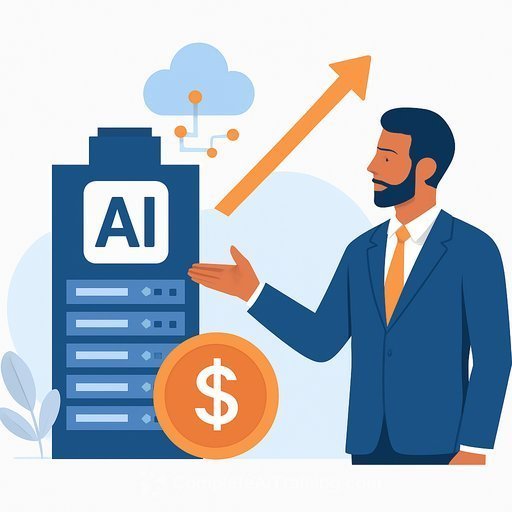Maximizing AI ROI in Sales: From AI-Washing to Real Revenue Growth for CROs
Before AI took over the roadmap, most leaders worried about one thing: getting reps to update the CRM. Now the questions are sharper. What's the ROI of our AI tools? Are reps adopting them? And how do we keep CRM discipline in a bloated stack?
The gap is real. AI promises smooth pipelines, but many teams are stuck doing more busy work faster. That's AI-washing: bold claims, unchanged workflows, and no revenue lift. This is a practical playbook for CROs to move from hype to outcomes.
Reality in Revenue Teams Today
AI is everywhere except where it counts: the buying moment. You have co-pilots, dashboards, and extra buttons. Pipeline velocity barely moves, because efficiency without prioritization is noise. Leaders need fewer steps to decisions-not more tools to manage.
1) Start With the Verb, Not the Vendor
Translate every AI claim into a job to be done. If the job isn't clear, the value isn't real.
- Assistants: Prep and context. Summarize accounts, draft emails, surface signals, speed up readiness.
- Agents: Orchestrate workflows. Qualify, enrich, schedule, update CRM, nudge next steps. When well-built, they're reliable operators-not toys.
- AI SDRs: Automate prospecting and triggers. They add capacity. Humans still run discovery and negotiation.
Jonathan Pogact recommends mapping tools to the customer buying stages-not your org chart. That keeps assistants and agents tied to measurable steps.
2) Efficiency Is a Coupon. Effectiveness Is the Catalyst.
"Giving time back" sounds nice. "Return on time" pays the bills. Efficiency saves minutes. Effectiveness removes chokepoints and advances deals.
- Automate the last mile: booking meetings, demos, proposals, order signatures. That's where ROI is visible and causal.
- Consolidate your stack so reps don't need to learn another portal. Adoption rises when AI is embedded where work already happens.
- Target bottlenecks: filter low-fit leads, progress stalled proposals, compress handoffs.
Eric Gilpin, CRO of G2, puts it clearly: "I don't want to be 'efficient.' I want to be effective; doing the right things, the right way, in the right order."
3) Measure the Work, Not the Wow
"AI-powered" is hype. Revenue comes from measurable lifts in actions that move deals.
- Quality (offline): Accuracy, relevance, tone, clarity-human-verified before rollout.
- Adoption (behavioral): Weekly active users and retention. Under 10-20% adoption = low impact.
- Efficiency (operational): Time per task and cycle time. Useful, but secondary.
- Business impact (commercial): Replies, meetings booked, stage conversion, opps created, opps won.
Tyler Phillips notes the closer you are to buyer actions-like AI-driven outreach that gets immediate replies-the easier it is to prove impact.
Common Pitfalls That Kill ROI
- Automating irrelevant tasks: If it doesn't touch revenue, it's theater.
- Under-prepped reps: Buyers shortlist before the call. Generic outreach loses deals. Use assistants to synthesize signals and sharpen discovery.
- Feature sprawl: Most users touch ~20% of features. Good products provide guardrails, guidance, and next-best actions.
As Jonathan Pogact says: speed on busy work doesn't equal revenue. Point AI at the right jobs in the right order.
AI SDRs, Assistants, and Agents: What the Data Shows
- SMB and mid-market: AI SDRs and assistants perform best-fast, simple, less integration overhead.
- Enterprise: Agents shine-multi-step orchestration, compliance, and control.
- Adoption varies by role and size: SMBs want lead access and speed. Enterprises need governance and integration.
- ROI follows adoption: Tools with weekly usage win. Everything else collects dust.
For independent validation, review software feedback in public sources like G2's sales intelligence category.
From AI-Washing to Revenue Reality: Guidance for CROs
- Audit the "AI in order to ___" gap: Each tool must map to a clear sales outcome.
- Automate the last mile first: Speed-to-lead, SDR-to-AE handoffs, meeting booked to demo held, quote to sign.
- Push for adoption parity: Weekly rep usage or it's shelfware.
- Align roles with ROI: Assistants for SMB reps; agents for enterprise workflows.
- Rationalize vendors: Fewer systems, tighter integration, clearer benchmarks.
A 30-Day Blueprint for CROs
- Week 1: Inventory every AI tool. Define the "in order to" outcome. Cut anything without a measurable impact.
- Week 2: Automate one last-mile workflow. Define agent roles and human checkpoints. Pilot with a small team.
- Week 3: Launch the scorecard. Track quality, adoption, efficiency, and business impact in one dashboard.
- Week 4: Consolidate to two core platforms. Set governance for ownership, escalation, branding, and privacy.
Is Your Team Doing AI-Washing?
Often, yes. Many roll out AI for "efficiency" but never tie it to the buying process. That's how you get more activity and the same number.
- Automate revenue-near steps first.
- Measure actions that move deals.
- Hold vendors and teams to weekly usage and business outcomes.
The teams that win shorten the path from intent to decision. Quiet, consistent progress beats loud feature drops.
FAQs
What is AI-washing?
Claiming AI adoption without measurable buyer-facing outcomes. It looks modern, but it doesn't move revenue.
Differences between AI SDRs, assistants, and agents?
Assistants handle prep and summarization. Agents run workflows like routing, scheduling, and CRM updates. AI SDRs automate prospecting and triggers; people still run discovery and negotiation.
How do we measure ROI?
Use the four-part scorecard: quality, adoption, efficiency, and business impact-anchored to replies, meetings, stage conversion, and closed-won.
Where is adoption strongest?
North America leads. APAC and Europe are growing. Markets like India, Australia, and France have room to expand.
How do we avoid AI-washing?
Use an "in order to" audit, automate last-mile steps first, align tools to role needs, and make weekly adoption the standard.
Next Step
If your team needs practical skill-building, review role-based programs at Complete AI Training. For fresh options worth piloting, check the latest AI courses.
Bottom line: Treat AI as purpose-built operators. Point them at the last mile, measure the work, and demand weekly usage. That's how you turn AI from hype into predictable revenue.
Your membership also unlocks:






